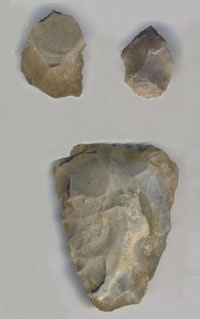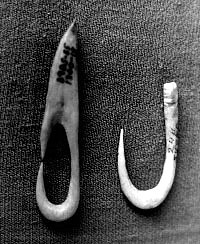
|

|

|

|
Stratum 10: Archaic Midden
What was once a large Archaic midden deposit has been dug out by relic collectors, leaving a large potholed trench. Nature, in the form of flooding, may also have played a role in disturbing the Archaic units. Notably, there is no discernable evidence of Early Archaic occupations in the shelter; rather, most appears to pertain to the Late Archaic period.
Although the midden stratum is considerably disturbed, a great deal of information was collected by archeological investigators. A key finding was evidence of bone fishhook manufacturing during the Archaic period. Details on this industry are provided in the section, Archaic Fishhook Manufacturing.
The midden was situated toward the front of the shelter, and was composed of sandy soil of river origin, stained and dirtied by human activities. It varies in thickness from nearly 4 feet thick in some areas to less than 1 foot in others. The north-south trench (denoted as a pothole in the image at top left) that was dug through the midden by collectors ranges from 2 to 4 feet in width and up to 3 feet deep and extends the total length of the south unit excavated area, some 30 feet in all.
Just as Historic Period occupants destroyed much of the midden, the digging activities of Archaic people, along with possible river flooding, truncated earlier strata underlying the midden, including the yellow clay and red sand deposits (Strata 8 and 9).
Archeologists discovered several Archaic features, including pits and fire hearths, below the midden level. A small pit which extended downward into Stratum 6 (the Red-Gray Mix) contained small amounts of charcoal, chert flakes, and bone in the fill. However, no reason could be determined for the use of this pit. Another small, rock-lined fire hearth was discovered in a pit dug into Substratum 8D, Red-White Spotted. This feature was one of the few in Horn Shelter in which stones were used. (Earlier Paleoindian fire hearths were built directly on the ground.)
More than 40 projectile points of at least seven types have been catalogued from Stratum 10. The variety of points suggests that Archaic groups staying at Horn Shelter had ties to areas in the west, on the Edwards Plateau, as well as to the east. The following distributional classification, based on this preliminary sample, shows the predominance of Edwards Plateau types:
West: Edwards PlateauNorth: |
East:Unable to Classify |
Other stone tools recovered from the midden were bifaces or knives, fragments of dart points and bifaces, a chopper, flint core, gravers, two metate fragments and two manos, ocher, and more than 175 utilized flakes. Eighteen of these flakes have the size and shape to be a very specialized tool, that is, a “fishhook-making tool.” A total of 33 specimens of bone fishhook materials was recovered from the south excavations at Horn Shelter. Although some are from other Archaic strata, most are from this midden.
Except for the bone hooks, only a few other modified bone artifacts were recovered: scraped bone fragments, bone pins made from jack rabbit radii, and bird wing bone. One antler tool fragment was 2¾ inches long, and had been ground flat the entire length of one side.
Evidence of animals processed for food was found in quantity. This includes hundreds of bone fragments of white-tailed deer, a number of which had cut marks, and bones of small mammals, including rabbits and rodents. Bird remains were common, including a few fragments of eggshell. Among fish bone, gar, freshwater drum, and channel catfish were identified, and both land and aquatic turtle were found. Mussels were probably utilized as a food source. Thousands of snail shells also were recovered; it is unclear whether the snails entered the midden as scavengers or whether they were used as food. Plant remains were scarce but include hackberry and one charred wild onion bulb.
Stratum 10 is dated by four radiocarbon dates: two on charcoal (3470+/-160 B.P. [Tx-1720] and 2330+/-60 B.P.[Tx-1999]) and two from snail shell (3690+/-70 B.P. [Tx-1995] and 2510+/-90 B.P. [Tx-2000]).

|

|

|
